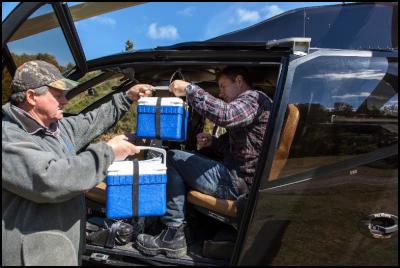Funding doubles for Hawke’s Bay kiwi project
www.duenorthpr.co.nz
25 October 2016

Heading for
protection. Forest Lifeforce Restoration Trust
staffer Barry Crene hands eggs destined for incubation at
Kiwi Encounter in Rotorua to Trust Chairman Simon
Hall.
Funding doubles for Hawke’s Bay kiwi project
Kiwi protection in Hawke’s Bay has received a massive shot in the arm through a doubling in funding for one of the region’s most prolific and successful conservation initiatives. The Maungataniwha Kiwi Project, run by the Forest Lifeforce Restoration Trust, has been given $20,000 by Kiwis for kiwi to help boost operations still further.
The extra money will help the Trust catch and monitor more male birds so that the eggs they guard can be retrieved and sent to Kiwi Encounter near Rotorua for incubation. The chicks from these eggs are then released once they are old enough to protect themselves from predators. They are put back into the Maungataniwha Native Forest, and other areas in inland Hawke’s Bay, to boost the population of the ‘Eastern Race’ kiwi region.
“We are immensely grateful to Kiwis for kiwi for this funding,” said Pete Shaw, the Forest Lifeforce Restoration Trust’s forestry manager. “It’s a vital part of our drive to turn the current two percent a year decline in kiwi numbers into a two percent recovery.”
“The Maungataniwha Kiwi Project is a great investment for us,” said Michelle Impey of Kiwis for kiwi, an independent charity that supports community-led kiwi conservation projects nationally by raising and distributing funds. “They have a great track record of success and consistently contribute in good numbers to Operation Nest Egg, our national egg collection and incubation programme.”
The Trust is about two months into the six-month 2016/2017 kiwi egg collection and incubation season and the signs so far is that it will be a good one. This is despite heavy snow in August which hampered egg collection and made staffers fear for both the eggs in the forest and the adult birds incubating them.
This year it is tracking 35 male birds, 10 more than last year.
Efforts to boost the number of kiwi in the Maungataniwha Native Forest are showing signs of success. Kiwi listening surveys are recording the highest number of calls since record-keeping started about a decade ago and the numbers of rats and stoats are at their lowest. This is due partly to trapping and poisoning and partly to the impact of the severe winter of 2015 which knocked back rat numbers across the country.
“We were poisoning rats at about the same time as their food ran out,” Mr Shaw said. “This knocked them for six and, with very few rats about, the stoats took a massive hit too.”
- ends –
About the Forest Lifeforce Restoration Trust
The Forest Lifeforce Restoration Trust was established in 2006 to provide direction and funding for the restoration of threatened species of fauna and flora, and to restore the ngahere mauri (forest lifeforce) in native forests within the Central North Island.
It runs eight main regeneration and restoration projects, involving native New Zealand flora and fauna, on three properties in the central North Island. It also owns a property in the South Island’s Fiordland National Park.
About Kiwis for kiwi:
Kiwis for kiwi, a fully independent charity aims to protect kiwi and their natural habitat, ensuring the species flourish for generations to come. It allocates funds to hands-on kiwi projects, raises sponsorship dollars, increases public awareness of the plight of kiwi and works alongside kiwi experts to provide resources, advice and best practice guidance to all those working to save kiwi. In partnership with Department of Conservation, Kiwis for Kiwi support the national Kiwi Recovery Programme. For more information: www.kiwisforkiwi.org
To donate or find out more visit: www.kiwisforkiwi.org


 Gordon Campbell: On The Government’s Latest Ferries Scam
Gordon Campbell: On The Government’s Latest Ferries Scam PSA: Disappointing Govt Attack On Diversity, Inclusion In Public Service
PSA: Disappointing Govt Attack On Diversity, Inclusion In Public Service NZ Labour Party: Govt Health And Safety Changes Put Workers At Risk
NZ Labour Party: Govt Health And Safety Changes Put Workers At Risk Amnesty International Aotearoa New Zealand: Democracy At Risk
Amnesty International Aotearoa New Zealand: Democracy At Risk Walk Without Fear Trust: New Sentencing Reforms Aimed At Restoring Public Safety Welcomed
Walk Without Fear Trust: New Sentencing Reforms Aimed At Restoring Public Safety Welcomed Rio Tinto & NZAS: Archaeological Project Underway From Historic Excavations At Tiwai Point
Rio Tinto & NZAS: Archaeological Project Underway From Historic Excavations At Tiwai Point New Zealand Deerstalkers Association: NZDA Urges Hunters To Prioritise Safety This Roar Season
New Zealand Deerstalkers Association: NZDA Urges Hunters To Prioritise Safety This Roar Season


